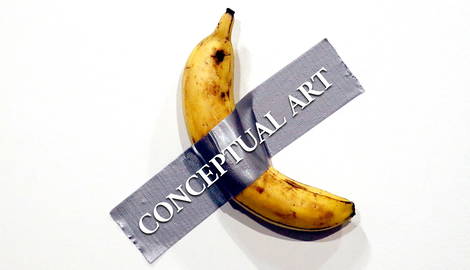
Conceptual art is a multifaceted art movement that has dominated the global art scene since the late 1960s. Its main concept is the rejection of physical and aesthetic qualities of the work of art in favor of its idea and preconceived meaning. Confused by this intangible and often unobvious approach, museum visitors often reject Conceptualism, tortured by their inability to find a fitting key for the interpretation. Read on to learn more about conceptual art, its criticism, and five things that will help you understand this art movement.
What is Conceptual Art?

Conceptual art emerged in the 1960s. Before that, abstraction dominated the art scene in the 1950s as well as the immediate physicality of Pop Art and the overintellectualized simplicity of Minimalism. Conceptual art was a philosophical way out of the preconceived notions of art and its limits.
Defining conceptual art is not an easy task since, unlike most other art movements, it has no shared features, no uniform style or theoretical framework, and no one-size-fits-all manifesto. Integral to the idea of conceptual art is the priority of idea over its visual qualities. However, Conceptual artists often insist that all art is essentially conceptual and that it comes from thought and not aesthetic expectation. Many historians and artists named Marcel Duchamp the father of Conceptual art, with his 1917 presentation of the urinal titled Fountain.

Moreover, Conceptualism rejects the idea of the inherent physical value of art pieces. For a conceptual artist, materials are interchangeable and have no value of their own. Thus, a piece can be reconstructed at any time from any objects available without damaging its meaning. This, however, presents a challenge for museum curators trained to preserve objects the way they were created.
Conceptual art has its roots in the early twentieth-century Dada movement that praised absurdity as a protest against reality. Dada artists similarly democratized artistic materials, relying on found objects, newspaper clippings, and other recycled elements from everyday life. Conceptual art in that context is the next step in the dematerialization of artwork and the dissolvent of its physical properties. While its precursive movement of Minimalism aimed to reduce artistic expression to the simplest of geometric forms, Conceptualism rejected the physicality altogether, putting metaphysics first. Here are some tips on how to approach conceptual art.
Tip #1: Let Go of Your Expectations

One of the features of conceptual art is deceiving the audience’s preconceived notions about art and its properties. Although conceptual artists sometimes reference symbols and concepts from the past centuries of art history, they rarely interpret them directly. Conceptualism targets the viewer’s brain rather than their eye or aesthetic taste. It is simultaneously a simplification of visual language and its transformative complication. In the words of an abstract artist Al Held: Conceptualism is just pointing at things. This act of pointing moves communication to another level, transgressing the traditional relationship between art and its audience.
Tip #2: Don’t Take The Materials Too Seriously

One of the fundamental mistakes made by someone approaching conceptual art is to expect particular aesthetic qualities or demonstration of artistic skill. In conceptualism, materials matter only as long as they adhere to the artist’s goal. The main labor of conceptual artist is conceiving their expression and imagining a suitable physical casing for it. The materials used for art objects are rarely unique or exclusive and are not fixed to a finished piece.
The famous installation One and Three Chairs by the father of Conceptualism Joseph Koshut consists of a wooden chair, its photograph, and a reprint of a dictionary definition of the word chair. The only thing that remained constant during the years of its presentation in various art institutions was the dictionary entry. The chair itself has no particular qualities and represents merely a concept, thus it can be swapped for any other chair available. This way, Koshut talks about the relationship between concepts and their physical embodiment, questioning which one is more real.
In terms of immediate artistic creation, conceptual artists are not necessarily expected to fabricate their pieces. The final work can be delegated or compiled from found materials that the artist leaves intact. Lawrence Weiner formulated his Declaration of Intent, another easily reproduced Conceptualist piece that became one of the movement’s manifestos. The level of physical involvement of the artist in the finished work remains entirely up to them and should not affect the final value of the work.
Tip #3 Consider the Social and Political Context

Devoid of direct physicality, Conceptual art nonetheless absorbs the influences and concerns of the physical world around its creator. Sometimes, a quick research into the artist’s biography and origins can give you the key to the interpretation of the piece. One of the iconic works of Conceptual art, the total installation of a Ukrainian-born artist Ilya Kabakov, is the literal representation of the Soviet dream of escapism.
The Man Who Flew Into Space from His Apartment is a small room entirely covered in posters and newspaper clippings of images of Soviet propaganda, cheerful news, and nausea-inducing slogans. Kabakov’s hero is anonymous, but his anxieties and concerns are familiar to everyone who lived through the Soviet routine. He occupied a small room in a communal apartment of random people unrelated to each other. Lack of personal space, lack of individuality, or room for thought forced him to build a catapult out of his bed and leave the prison of political hypocrisy and everyday abuse. Simultaneously, by leaving the earth, he fulfilled the ultimate dream of almost every Soviet child, raised in the narrative of space exploration.
Tip #4: Mind the Language

Many works of conceptual art are text-based, presenting nothing but a combination of words on gallery walls. Conceptualists working with text explore the limits of language and its relationship to visual art, as well as the non-universality of verbal language subject to multiple interpretations. We are used to looking at art pieces and then reading their descriptions in catalogs or museum labels. Thus, text accompanies the work, deciphering it for the audience. But what if the work itself is a line of text? As an alternative to the emotional effect caused by line and color in traditional painting, Conceptualist artists explore the power of carefully weighted words upon one’s psyche and thought process.
Tip #5: Think of the Power Dynamics

The goal of conceptual art is not always to present a challenge to its audience. Sometimes, an artist targets art institutions, their rigid systems, and bureaucracy. Previously, we have already seen how the material aspect of Conceptualism goes against the traditional notions and values of museum curation. Sometimes, the artists go even further, ridiculing the art world that aims to dominate them.
Marcel Broodthaers, a Belgian poet and artist, is considered one of the most important conceptual artists, although his name rarely gets mentioned in the media. In 1968, Broodthaers came up with an installation titled Museum of Modern Art – Department of Eagles. The ‘museum’ was a collection of random eagle-themed objects categorized according to vague guidelines yet organized with a grave seriousness typical for respectable art institutions. The museum had no fixed place and no permanent collection and soon closed due to the lack of funding. This project was Broodthaer’s commentary on the outdated and self-centered cultural institutions, unable to grasp the real understanding of culture.
Conceptual Art: Criticism and Opposition

For decades since its emergence, conceptual art has been criticized for its inherent elitism. Departing the realm of clear visual communication in favor of contextualization and intellectualism, conceptual art became inaccessible to the larger public, requiring time, effort, and specific knowledge about the artist and their theoretical framework. With the democratization of materials came the metaphysical complexity that sometimes turns into a meaningless piling of fashionable terms and imaginary issues.
Others argue that the methodology of conceptual art in the era of mass production contributed to the death of craftsmanship in arts. Compiling found objects into an art piece or outsourcing the artistic process to external professionals removed the need for the artist’s physical and aesthetical involvement. Moreover, it threatened the myth of the artist as a creative individual developing skills and making a material effort with their hand.

However, these arguments partially dissolve if we look at the history of art and the state of the art market today. Fortunately or not, elitism has always been a part of the high art world. The realm of successful artists, rich collectors, and powerful institutions was and remains by definition an exclusive place with strict requirements to its actors.
In the Pre-Modern era, figurative painting of mythological scenes, still-life compositions, and portraits was riddled with complex symbolism readable only to those with access to education. Although dismantling the status quo is necessary to implement healthier patterns into the system, Conceptual art hardly offers something new in terms of the market structure. The concern for the inaccessibility of art is valid, but the Conceptualist trend was merely a product of it, not its trigger.
The fear of craftsmanship dying has its reasons as well, but the current trends suggest a more optimistic outlook. More and more contemporary artists return to traditional crafts and hand-made objects as a protest against mass production and uniform globalized fashions. In the years following the pandemic isolation, the need for human interactions and hand labor has progressed. In a world filled with mass-produced goods, artisan practices regained their value, and contemporary artists’ practices reflected the trend. Most likely, we are dealing with a recurring trend of craft versus standardization and maximalism versus minimalism that has haunted the world of art for centuries, from the emergence of the Arts and Crafts Movement to the Bauhaus.










